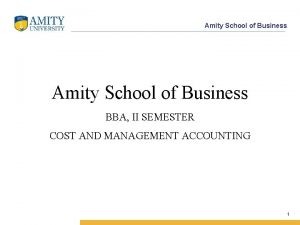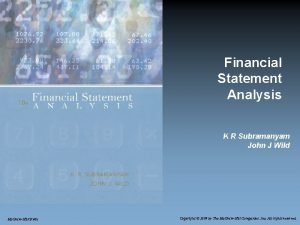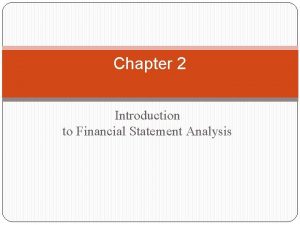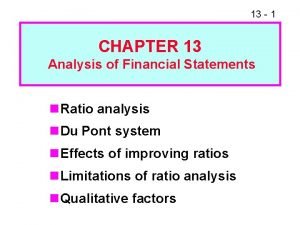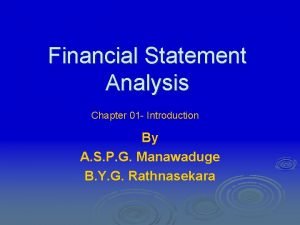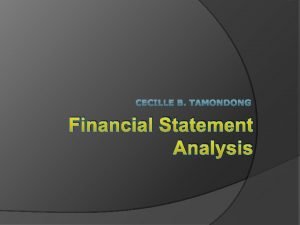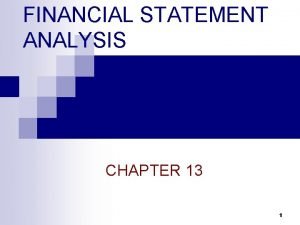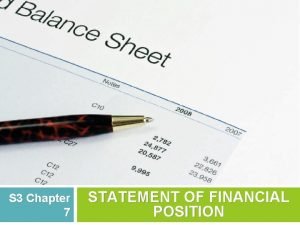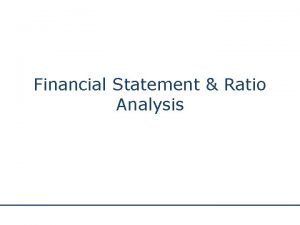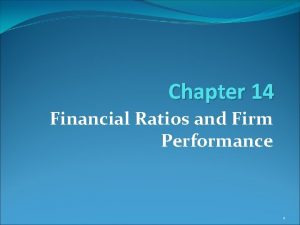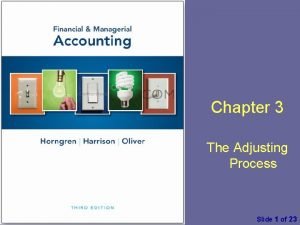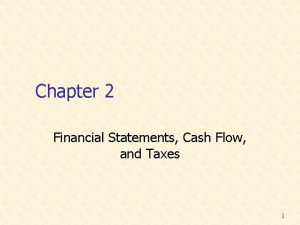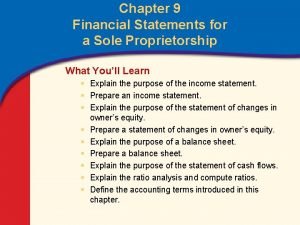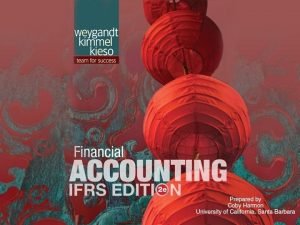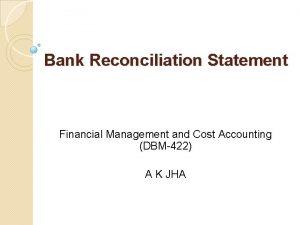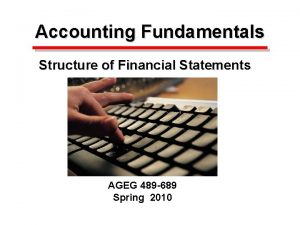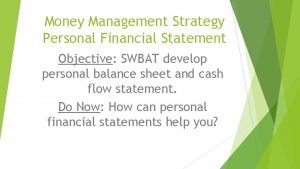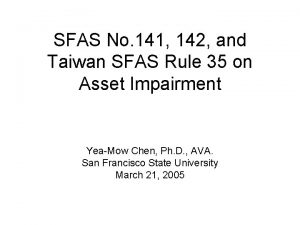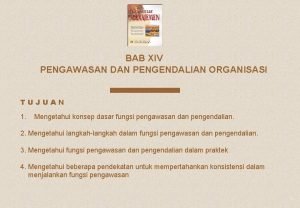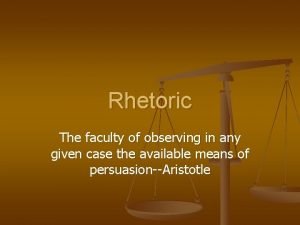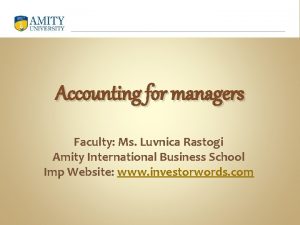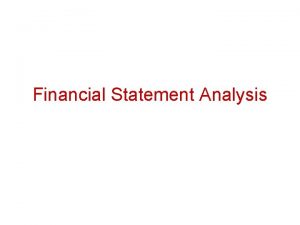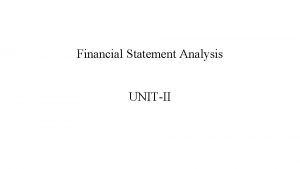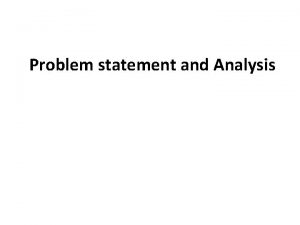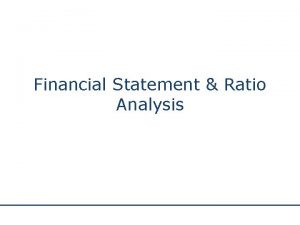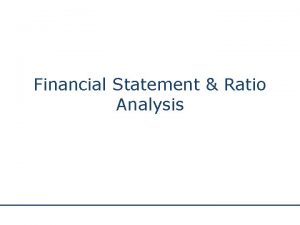Financial Statement Analysis Faculty Ms Luvnica Rastogi Amity




































































































































- Slides: 132

Financial Statement Analysis Faculty: Ms. Luvnica Rastogi Amity International Business School Imp Website: www. investorwords. com

Financial Analyst and Financial Analysis Financial Analyst: The financial analyst can be viewed as any user of available information concerning firms who wishes to use the information for the purpose of decision making. Financial Analysis: It is the procedure the financial analyst uses to interpret the information.

Financial Statement Analysis The art of transforming data from Financial Statements into information that is useful for informed decision making is called Financial Statement Analysis. The firm itself and outside providers of capital (creditors and investors) all undertake financial statement analysis. The type of analysis varies according to the specific interest of the party involved.

Examples of External Uses of Financial Statement Analysis Trade Creditors -- Focus on the liquidity of the firm. Their claims are short term, and the ability of the firm to pay these claims quickly is best judged by an analysis of the firm’s liquidity.

Bondholders -- Focus on the long-term cash flow of the firm. Because the Bondholder are more interested in the cash flow ability of the firm to service Debt over a long period of time. They may evaluate this ability by analyzing the capital structure of the firm, the major sources and uses of funds, the firm’s profitability over time and projection of future profitability.

Shareholders -- Focus on the profitability and long- term health of the firm. They would also be concerned with the firm financial condition.

Examples of Internal Uses of Financial Statement Analysis Plan -- Focus on assessing the current financial position and evaluating potential firm opportunities in relation to this current position. Control – With respect to internal control, the financial manager is particularly concerned with the return on investment provided by the company and with the efficiency of assets management.

Understand –To bargain effectively for outside funds, Financial Manager need to Focus on all aspect of financial analysis for understanding how suppliers of funds analyze the firm.

Primary Types of Financial Statements Balance Sheet A summary of a firm’s financial position on a given date that shows total assets = total liabilities + owners’ equity. Income Statement u A summary of a firm’s revenues and expenses over a specified period, ending with net income or loss for the period.

Basket Wonders’ Balance Sheet (Asset Side) Basket Wonders Balance Sheet (thousands) Dec. 31, 2003 a Cash and C. E. $ 90 Acct. a. How the firm stands on a Rec. c 394 specific date. Inventories 696 b. What BW owned. Prepaid Exp d 5 Accum c. Amounts owed by customers. Tax Prepay 10 d. Future expense items Current Assetse $1, 195 Fixed already paid. Assets (@Cost)f 1030 Less: Acc. e. Cash/likely convertible to Depr. g (329) Net Fix. cash within 1 year. Assets $ 701 Investment, LT f. Original amount paid. 50 Other Assets, LT g. Acc. deductions for wear 223 Total Assets and tear. b $2, 169

Basket Wonders’ Balance Sheet (Liability Side) Basket Wonders Balance Sheet (thousands) Dec. 31, 2003 Notes Payable $ 290 a. Note, Assets = Liabilities + Acct. Payablec 94 Accrued Equity. Taxes d 16 Other Accrued b. What BW owed and Liab. d 100 ownership position. Current Liab. e $ 500 Long c. Owed to suppliers for goods -Term Debt f 530 and services. Shareholders’ Equity Com. d. Unpaid wages, salaries, etc. Stock ($1 par) g 200 Add Pd e. Debts payable < 1 year. in Capital g 729 Retained f. Debts payable > 1 year. Earnings h 210 Total Equity g. Original investment. $1, 139 h. Earnings reinvested. a, b Total Liab/Equity $2, 169

Basket Wonders’ Income Statement Basket Wonders Statement of Earnings (in thousands) for Year Ending December 31, 2003 a Net Sales b $ 2, 211 Cost a. Measures profitability over a of Goods Sold 1, 599 Gross time period. Profit $ 612 SG&A Expenses c b. Received, or receivable, from 402 EBITd customers. $ 210 Interest Expense c. Sales comm. , adv. , officers’ 59 EBT f salaries, etc. $ 151 Income Taxes d. Operating income. 60 EATg e. Cost of borrowed funds. $ 91 Cash Dividends f. Taxable income. 38 Increase in RE g. Amount earned for $ 53 shareholders.

Cross Sectional Financial Statement Studies There is little to be gained by analyzing the financial statements of a company for one year alone. A “benchmark” is needed by which to judge a company’s performance. This “benchmark” can be obtained by comparing companies with in the same industries with other companies. This is known as a cross-sectional study.

Time Series Financial Statement Studies To compare the accounts of one company with its own previous years. Possible to see if a company is improving in certain areas or not. This is known as a Time series study.

Use of Financial Ratios A Financial Ratio is an index that relates two accounting numbers and is obtained by dividing one number by the other. Types of Comparisons Internal Comparisons External Comparisons

Internal Comparisons To compare a present ratio with past and expected future ratios for the same company is called Internal comparisons. For example to compare the Kardan 2008 ratios with Kardan 2007 and 2006 ratios that either they have improved or not.

External Comparison This involves comparing the ratios of one firm with those of similar firms or with industry averages. Or To compare the ratios of one firm with those of similar firms or with industry averages at the same point in time is called External Comparisons. Similarity is important as one should compare “apples to apples. ” Example: to compare the ratios of Kardan and Bakhtar

How a Ratio is expressed? �As Percentage - such as 25% or 50%. For example if net profit is Rs. 25, 000/- and the sales is Rs. 1, 000/then the net profit can be said to be 25% of the sales. �As Proportion - The above figures may be expressed in terms of the relationship between net profit to sales as 1 : 4. �As Pure Number /Times - The same can also be expressed in an alternatively way such as the sale is 4 times of the net profit or profit is 1/4 th of the sales.

Why are ratios useful? Ratios standardize numbers and facilitate comparisons. Ratios are used to highlight weaknesses and strengths.

Types of Ratios (i) Liquidity Ratios (ii) Financial Leverage (Debt) Ratios (iii) Coverage Ratios (iv) Activity Ratios (v) Profitability Ratios (vi) Investment Ratios

Liquidity Ratios Balance Sheet Ratios Liquidity Ratios Ratio’s that measure a firm’s ability to meet short term obligations. Or It shows that Can we make required payments?

Liquidity Ratios Liquidity ratios are used to measure a firm ability to meet short term obligations. They compare short term obligations with short term (or current) resources available to meet these obligations. From these ratios, much insight can be obtained into the present cash solvency of the firm.

Liquidity Ratios Balance Sheet Ratios Liquidity Ratios Current Ratio (ii) Acid test (quick) Ratio (i)

Liquidity Ratios Balance Sheet Ratios Current Ratio Shows a firm’s ability to cover its current liabilities with its current assets. Or It is the relationship between the current assets and current liabilities of a firm.

Liquidity Ratios Balance Sheet Ratios Current Ratio Liquidity Ratios Current Assets Current Liabilities If Current Assets = Rs. 1, 195 and Current Liabilities = Rs. 500 Rs. 1, 195 = 2. 39 Rs. 500

Current Ratio Looks at the ratio between Current Assets and Current Liabilities Ideal level? – 1. 5 A ratio of 2. 39 would imply the firm has $2. 39 of current assets to cover every $1 in current liabilities Too high – Might suggest that too much of its assets are tied up in unproductive activities – too much stock, for example? Too low - risk of not being able to pay Current liabilities.

Liquidity Ratio Comparisons Current Ratio Year 2003 2002 2001 BW 2. 39 2. 26 1. 91 Industry 2. 15 2. 09 2. 01 Ratio is stronger than the industry average.

Liquidity Ratios Balance Sheet Ratios Acid test (quick) Ratio Shows a firm’s ability to meet current liabilities with its most liquid assets. Or It is the ratio between Quick Current Assets and Current Liabilities.

Liquidity Ratios Balance Sheet Ratios Acid-Test (Quick) Liquidity Ratios Current Assets - Inv Current Liabilities If Current Assets = $1, 195 and Current Liabilities = $500 Inventory = $696 $1, 195 - $696 = 1. 00 $500

Acid Test (quick) Ratio 1 seen as ideal It has been argued that Inventory takes a while to convert to cash so a more realistic ratio would ignore Inventory. The omission of Inventory gives an indication of the cash the firm has in relation to its liabilities (what it owes) A ratio of 1 would imply that the firm has $1 of cash to cover every $1 in current liabilities. Again if it is too high means that the business is very liquid – may be able to use the cash for other activities to increase performance. If it is too low then the business may face problems in payment of current liabilities. Some types of business need more cash than others so acid test would be expected to be higher

Liquidity Ratio Comparisons Acid-Test Ratio Year 2003 2002 2001 BW 1. 00 1. 04 1. 11 Industry 1. 25 1. 23 1. 25 Ratio is weaker than the industry average.

Summary of the Liquidity Ratio Comparisons Ratio Current Acid-Test BW 2. 39 1. 00 Industry 2. 15 1. 25 Strong current ratio and weak acid-test ratio indicates a potential problem in the inventories account. Note that this industry has a relatively high level of inventories.

Current Ratio -- Trend Analysis Comparison Ratio Value Trend Analysis of Current Ratio 2, 9 2, 7 2, 5 2, 3 2, 1 1, 9 1, 7 1, 5 2001 BW Industry 2002 Analysis Year 2003

Acid-Test Ratio -- Trend Analysis Comparison Trend Analysis of Acid-Test Ratio Value 1, 5 1, 3 1, 0 BW Industry 0, 8 0, 5 2001 2002 Analysis Year 2003

Summary of the Liquidity Trend Analysis u The current ratio for BW has been rising at the same time the acid-test ratio has been declining. The current ratio for the industry has been rising slowly at the same time the acid-test ratio has been relatively stable. This indicates that inventories are a significant problem for BW. BW

Financial Leverage (Debt) Ratios Balance Sheet Ratios Financial Leverage Ratios Shows the extent to which the firm is financed by debt.

Financial Leverage (Debt) Ratios Balance Sheet Ratios Financial Leverage Ratios (i). Debt-to-Equity (ii). Debt-to-Total-Assets (iii). Total Capitalization

Financial Leverage (Debt) Ratios Balance Sheet Ratios Debt-to-Equity It is the relationship between borrower’s fund (Debt) and Owner’s Capital (Equity). The Debt to Equity ratio is computed by simply dividing the total debt of the firm (including current liabilities) by its share holder’s equity.

Financial Leverage Ratios Balance Sheet Ratios Financial Leverage Ratios If Total Debt = 1030 and Shareholder’s equity = 1139 Debt-to-Equity Total Debt Shareholders’ Equity For Basket Wonders December 31, 2003 $1, 030 =. 90 $1, 139

Debt-to-Equity Ratio The ratio 0. 90 tells us that creditors are providing 90 cents of financing for each $1 being provided by shareholder’s. Creditors would generally like this ratio to be low. The lower the ratio the higher the level of the firm’s financing that is being provided by shareholder’s, and the larger the creditor cushion (margin of protection) in the event of losses.

Financial Leverage Ratio Comparisons Debt-to-Equity Ratio Year 2003 2002 2001 BW. 90. 88. 81 Industry. 90. 89 BW has average debt utilization relative to the industry average.

Financial Leverage (Debt) Ratios Balance Sheet Ratios Debt-to-Total-Assets Shows the percentage of the firm’s assets that are supported by debt financing. or It is the relationship between borrower’s fund (Debt) and total Assets.

Financial Leverage Ratios Balance Sheet Ratios Financial Leverage Ratios If Total Debt = 1030 And Total assets = 2169 Debt-to-Total-Assets Total Debt Total Assets For Basket Wonders December 31, 2003 $1, 030 =. 47 $2, 169

Debt-to-Total-Assets Ratio This ratio highlights the relative importance of debt financing to the firm by showing the percentage of the firm’s assets that is supported by debt financing. The 0. 47 ratio shows that 47 percent of the firm assets are financed by debt and remaining 53 percent of the finance comes from shareholder’s equity.

Once again this ratio points out that the greater the percentage of financing provided by shareholder’s equity, the larger the cushion of protection offered the firm’s creditors. In short the higher the Debt to total assets ratio, the greater the financial risk; the lower the ratio, the lower the financial risk.

Financial Leverage Ratio Comparisons Debt-to-Total-Asset Ratio Year 2003 2002 2001 BW. 47. 45 Industry. 47. 47 BW has average debt utilization relative to the industry average.

Financial Leverage (Debt) Ratios Balance Sheet Ratios Long term Debt to Total Capitalization(i. e. , LT-Debt + Equity) Capitalization Shows the relative importance of long-term debt to the long-term financing of the firm. Total capitalization represents all long term debt and shareholder’s equity.

Financial Leverage Ratios Balance Sheet Ratios Total Capitalization Financial Leverage Ratios Long Term Debt Total Capitalization If Long term Debt = 530 And LT-debt + Equity = 1669 For Basket Wonders December 31, 2003 (i. e. , LT-Debt + Equity) $530 =. 32 $1, 669

This measure tells us the relative importance of long term debt to the long term financing of the firm. The 0. 32 ratio shows that 32 percent of the firm total long term financing is provided by long term debt and remaining 68 percent of the finance comes from shareholder’s equity.

Financial Leverage Ratio Comparisons Total Capitalization Ratio Year 2003 2002 2001 BW. 32. 34. 33 Industry. 30. 32. 31 BW has average long-term debt utilization relative to the industry average.

In summary, debt ratios tell us the relative proportions of capital contribution by creditors and by owners.

Coverage Ratios Income Statement Ratios Coverage Ratios that relates the financial charges (interest) of a firm to its ability to service or cover them.

Coverage Ratios Income Statement Ratios Coverage Ratios (i) Interest Coverage ratio

Coverage Ratios Income Statement Ratios Interest Coverage Ratio It Indicates a firm’s ability to cover interest charges. It is also called times interest earned.

Coverage Ratios Income Statement Ratios Coverage Ratios If EBIT = 210 And Interest Charges = 59 Interest Coverage EBIT Interest Charges For Basket Wonders December 31, 2003 $210 = 3. 56 $59

This ratio serves as one measure of the firm’s ability to meet its interest payments and avoid bankruptcy. In general the higher the ratio, the greater the likelihood that the company could cover its interest payments without difficulty. It also sheds some light on the firm capacity to take on new debt.

Ratio of 3. 56 shows the BW ability to cover annual interest 3. 56 times with operating income (EBIT).

Coverage Ratio Comparisons Interest Coverage Ratio Year 2003 2002 2001 BW 3. 56 4. 35 10. 30 Industry 5. 19 5. 02 4. 66 BW has below average interest coverage relative to the industry average.

Coverage Ratio -- Trend Analysis Comparison Trend Analysis of Interest Coverage Ratio Value 11, 0 9, 0 7, 0 BW Industry 5, 0 3, 0 2001 2002 Analysis Year 2003

Summary of the Coverage Trend Analysis u The interest coverage ratio for BW has been falling since 2001. It has been below industry averages for the past two years. This indicates that low earnings (EBIT) may be a potential problem for BW. BW Note, we know that debt levels are in line with the industry averages.

EXERCISE 1 LIABILITES Capital Reserves ASSETS 180 Net Fixed Assets 20 Inventories Term Loan 300 Cash Bank C/C 200 Receivables Trade Creditors 50 Goodwill Provisions 50 800 a. b. c. d. e. f. 400 150 50 800 What is the Net Worth : Capital + Reserve = 200 Tangible Net Worth is : Net Worth - Goodwill = 150 Outside Liabilities : TL + CC + Creditors + Provisions = 600 Net Working Capital : C A - C L = 350 - 250 = 50 Current Ratio : C A / C L = 350 / 300 = 1. 17 : 1 Quick Ratio : Quick Assets / C L = 200/300 = 0. 66 : 1

EXERCISE 2 LIABILITIES 2005 -06 2006 -07 Capital 300 350 Net Fixed Assets 730 750 Reserves 140 160 Security Electricity 30 30 Bank Term Loan 320 280 Investments 110 Bank CC (Hyp) 490 580 Raw Materials 150 170 Unsec. Long T L 150 170 S I P 20 30 Creditors (RM) 120 70 Finished Goods 140 170 Bills Payable 40 80 Cash 30 20 Expenses Payable 20 30 Receivables 310 240 Provisions 20 40 Loans/Advances 30 190 50 50 1600 1760 Goodwill Total 1600 1760 1. Tangible Net Worth for 1 st Year : ( 300 + 140) - 50 = 390 2. Current Ratio for 2 nd Year : (170 + 30 +170+20+ 240 + 190 ) / (580+70+80+70) 820 /800 = 1. 02 3. Debt Equity Ratio for 1 st Year : 320+150 / 390 = 1. 21

Exercise 3. LIABIITIES ASSETS Equity Capital 200 Net Fixed Assets 800 Preference Capital 100 Inventory 300 Term Loan 600 Receivables 150 Bank CC (Hyp) 400 Investment In Govt. Secu. Sundry Creditors 100 Preliminary Expenses Total 1400 1. Debt Equity Ratio will be : 600 / (200+100) 50 100 1400 = 2: 1 2. Tangible Net Worth : Only equity Capital i. e. = 200 3. Total Outside Liabilities / Total Tangible Net Worth : (600+400+100) / 200 = 11 : 2 4. Current Ratio will be : (300 + 150 + 50 ) / (400 + 100 ) = 1 : 1

Exercise 4. LIABILITIES ASSETS Capital + Reserves 355 P & L Credit Balance Net Fixed Assets 7 Cash Loan From S F C 100 Receivables 265 1 125 Bank Overdraft 38 Stocks Creditors 26 Prepaid Expenses 1 Provision of Tax 9 Intangible Assets 30 Proposed Dividend 15 550 Q. What is the Current Ratio ? Q What is the Quick Ratio ? 550 Ans : (1+125 +128+1) / (38+26+9+15) : 255/88 = 2. 89 : 1 Ans : (125+1)/ 88 = 1. 43 : 11 Q. What is the Debt Equity Ratio ? 128 Ans : LTL / Tangible NW = 100 / ( 362 – 30) = 100 / 332 = 0. 30 : 1

Activity Ratios Income Statement/Balance Sheet Ratios Activity Ratios that measure how effectively the firm is using its assets are called Activity Ratios.

Activity ratios, also known as Efficiency or Turnover Ratio, measure how effectively the firm is using its assets. In this section, we will focus our attention primarily on how effectively the firm is managing two specific asset groups receivables and inventories and its total assets in general.

Activity Ratios Income Statement/Balance Sheet Ratios Activity Ratios (i) (iii) (iv) (vi) Receivable turnover Ratio Average Collection Period (Receivable turnover in Days) Payable turnover Ratio Average Payable Period (Payable Turnover in Days) Inventory Turnover Ratio Total Assets turnover ratio

Activity Ratios Income Statement/Balance Sheet Ratios Receivable Turnover Ratio Indicates quality of receivables and how successful the firm is in its collections. This is also called Debtors Velocity or Average Collection Period or Period of Credit given.

Activity Ratios Income Statement / Balance Sheet Ratios Activity Ratios If Annual Net Credit Sales = 2211 And Account Receivables = 394 Receivable Turnover (Assume all sales are credit sales. ) Annual Net Credit Sales Receivables For Basket Wonders December 31, 2003 $2, 211 = 5. 61 $394

This ratio tells us the number of times accounts receivables have been turned over (turned into cash) during year. The higher the turnover, the shorter the time between the typical sales and cash collection, and vise versa. For BW ratio 5. 61 tells us that 5. 61 times accounts receivables have been turned over (turned into cash) in 2003.

Activity Ratios Income Statement/Balance Sheet Ratios Average Collection Period Average number of days that receivables are outstanding. (or Receivable Turnover in days)

Activity Ratios Income Statement / Balance Sheet Ratios Activity Ratios If Days in the year = 365 And Receivable turn over = 5. 61 Average Collection Period Days in the Year Receivable Turnover or Receivables * Days in the year Annual Credit sales For Basket Wonders December 31, 2003 365 5. 61 = 65 days

It Gives a measure of how long it takes the business to recover debts. 65 days means that Average collection period of BW is 65 days. Shorter period is better as get cash more quickly.

Activity Ratio Comparisons Average Collection Period Year 2003 2002 2001 BW 65. 0 71. 1 83. 6 Industry 65. 7 66. 3 69. 2 BW has improved the average collection period to that of the industry average.

Activity Ratios Income Statement/Balance Sheet Ratios Payable Turnover Ratio Indicates the promptness of payment to suppliers by the firm.

Activity Ratios Income Statement / Balance Sheet Ratios Activity Ratios If Annual Credit Purchases = 1551 And Account Payable = 94 Payable Turnover (PT) (Assume annual credit purchases = $1, 551. ) Annual Credit Purchases Accounts Payable For Basket Wonders December 31, 2003 $1551 = 16. 5 $94

When a firm wants to study its own promptness of payment to suppliers or that of a potential credit customer. In such cases it may desirable to analyze the payable turnover ratio. For BW ratio 16. 5 tells us that 16. 5 times accounts payable have been turned over (turned into cash means paid to the suppliers) in 2003.

Activity Ratios Income Statement/Balance Sheet Ratios Payable Turnover in Days Average number of days that payables are outstanding. This is also called Creditors Velocity Ratio, which determines the creditor payment period.

Activity Ratios Income Statement / Balance Sheet Ratios Activity Ratios If Days in the year = 365 And Payable turnover = 16. 5 PT in Days in the Year Payable Turnover Or Accounts payable * Days in the year Annual Credit Purchases For Basket Wonders December 31, 2003 365 16. 5 = 22. 1 days

The average payable period is valuable information in evaluating the probability that a credit applicant will pay on time. If the average of payables is 48 days and the terms in industry are “net 30” we know that a portion of the applicant’s payables is not being paid on time. Ratio of 22. 1 means that the business paid the Accounts Payables in 22. 1 days on average.

Activity Ratio Comparisons Payable Turnover in Days Year 2003 2002 2001 BW 22. 1 25. 4 43. 5 Industry 46. 7 51. 1 48. 5 BW has improved the PT in Days.

Activity Ratios Income Statement/Balance Sheet Ratios Inventory Turnover Ratio Indicates the effectiveness of the inventory management practices of the firm. Or The rate at which a company’s Inventory is turned over is called Inventory turnover ratio.

Activity Ratios Income Statement / Balance Sheet Ratios Activity Ratios If CGS = 1599 And Inventory = 696 Inventory Turnover Cost of Goods Sold Inventory For Basket Wonders December 31, 2003 $1, 599 = 2. 30 $696

Inventory turnover A high Inventory turnover might mean increased efficiency? But: dependent on the type of business – supermarkets might have high inventory turnover ratios whereas a shop selling high value musical instruments might have low inventory turnover ratio. Low Inventory turnover could mean poor customer satisfaction if people are not buying the goods. Ratio of 2. 30 means that the company converts Inventory into A/R through sales 2. 30 times in one year.

Activity Ratio Comparisons Inventory Turnover Ratio Year 2003 2002 2001 BW 2. 30 2. 44 2. 64 Industry 3. 45 3. 76 3. 69 BW has a very poor inventory turnover ratio.

Inventory Turnover Ratio -Trend Analysis Comparison Trend Analysis of Inventory Turnover Ratio Value 4, 0 3, 5 3, 0 BW Industry 2, 5 2, 0 2001 2002 Analysis Year 2003

Activity Ratios Income Statement/Balance Sheet Ratios Total Assets Turnover Ratio Indicates the overall effectiveness of the firm in utilizing its assets to generate sales. Or The relationship of net sales to total assets is known as total assets turnover ratio.

Activity Ratios Income Statement / Balance Sheet Ratios Activity Ratios If Net Sales = 2211 And Total Assets = 2169 Total Asset Turnover Net Sales Total Assets For Basket Wonders December 31, 2003 $2, 211 = 1. 02 $2, 169

Asset Turnover ratio It looks at a businesses sales compared to the assets used to generate the sales. A ratio of 1. 02 means that BW generate $1. 02 sales revenue on each $1 investment in assets. Businesses with a high value of assets who have few sales will have a low asset turnover ratio If a business has a high sales and a low value of assets it will have a high asset turnover ratio Businesses can improve this by either increasing sales performance or getting rid of any additional assets

Activity Ratio Comparisons Total Asset Turnover Ratio Year 2003 2002 2001 BW 1. 02 1. 03 1. 01 Industry 1. 17 1. 14 1. 13 BW has a weak total asset turnover ratio.

Excessive investment in receivables and inventories increase assets and hence decrease the ratio. If BW could generate the same sales revenue with fewer dollar invested in receivables and inventories, total asset turnover ratio would improve.

Profitability Ratios Income Statement/Balance Sheet Ratios Profitability Ratios that relate profits to sales and investment are called profitability ratios. Or Profitability ratios measures that how much profit the firm generates.

Profitability Ratios Income Statement/Balance Sheet Ratios Profitability Ratios Gross Profit Margin (ii) Net Profit Margin (iii) Return On Investment (iv) Return on Equity (i)

Profitability Ratios Income Statement/Balance Sheet Ratios Gross Profit Margin Indicates the efficiency of operations and firm pricing policies. Or It shows the relationship between Gross profit and sales.

Profitability Ratios Income Statement / Balance Sheet Ratios Profitability Ratios If Gross Profit = 612 And Net Sales = 2211 Gross Profit Margin Gross Profit Net Sales For Basket Wonders December 31, 2003 $612 =. 277 $2, 211

Gross Profit Margin The higher the better Enables the firm to assess the impact of its sales and how much it cost to generate (produce) those sales. A gross profit margin of. 277 means that for every $1 of sales, the firm makes $27. 7 cents in gross profit.

Profitability Ratio Comparisons Gross Profit Margin Year 2003 2002 2001 BW 27. 7% 28. 7 31. 3 Industry 31. 1% 30. 8 27. 6 BW has a weak Gross Profit Margin.

Gross Profit Margin -Trend Analysis Comparison Trend Analysis of Gross Profit Margin Ratio Value (%) 35, 0 32, 5 30, 0 BW Industry 27, 5 25, 0 2001 2002 Analysis Year 2003

Profitability Ratios Income Statement/Balance Sheet Ratios Net Profit Margin Indicates the firm’s profitability after taking account of all expenses and income taxes. Or It shows the relationship between Net profit and sales.

Profitability Ratios Income Statement / Balance Sheet Ratios Profitability Ratios If Net profit = 91 And Net Sales = 2211 Net Profit Margin Net Profit after Taxes Net Sales For Basket Wonders December 31, 2003 $91 =. 041 $2, 211

Net Profit Margin Net profit margin looks at how much of the sales revenue is left as net profit. A net profit margin of. 041 means that for every $1 of sales, the firm makes $4. 1 cents in net profit. Net profit is more important than gross profit for a business as all costs are included A business would like to see that this ratio has improved over time.

Profitability Ratio Comparisons Net Profit Margin Year 2003 2002 2001 BW 4. 1% 4. 9 9. 0 Industry 8. 2% 8. 1 7. 6 BW has a poor Net Profit Margin.

Net Profit Margin -Trend Analysis Comparison Trend Analysis of Net Profit Margin Ratio Value (%) 10 9 8 7 BW 6 Industry 5 4 2001 2002 Analysis Year 2003

Profitability Ratios Income Statement/Balance Sheet Ratios Return on Investment Indicates the profitability on the assets of the firm (after all expenses and taxes). Or It shows the relationship between Net profit and total assets.

Profitability Ratios Income Statement / Balance Sheet Ratios Profitability Ratios If Net profit = 91 And Total assets = 2160 Return on Investment Net Profit after Taxes Total Assets For Basket Wonders December 31, 2003 $91 =. 042 $2, 160

Return on Investment The higher the better Shows how effective the firm is in using its assets to generate profit. A return on investment of 0. 042 means that it uses every $1 of assets to generate 4. 2 cents in profit.

Profitability Ratio Comparisons Return on Investment Year 2003 2002 2001 BW 4. 2% 5. 0 9. 1 Industry 9. 8% 9. 1 10. 8 BW has a poor Return on Investment.

Return on Investment – Trend Analysis Comparison Trend Analysis of Return on Investment Ratio Value (%) 12 10 8 BW Industry 6 4 2001 2002 Analysis Year 2003

Profitability Ratios Income Statement/Balance Sheet Ratios Return on Equity Indicates the profitability to the shareholders of the firm (after all expenses and taxes). Or It shows the relationship between Net profit and Shareholder’s Equity.

Profitability Ratios Income Statement / Balance Sheet Ratios Profitability Ratios If Net profit = 91 And Shareholder’s equity =1139 Return on Equity Net Profit after Taxes Shareholders’ Equity For Basket Wonders December 31, 2003 $91 =. 08 $1, 139

Return on Equity The higher the better Shows how effective the firm is in using its Shareholder’s equity to generate profit. A return on equity of 0. 08 means that it uses every $1 of shareholder’s equity to generate 8 cents in profit.

Profitability Ratio Comparisons Return on Equity Year 2003 2002 2001 BW Industry 8. 0% 17. 9% 9. 4 17. 2 16. 6 20. 4 BW has a poor Return on Equity.

Return on Equity -Trend Analysis Comparison Trend Analysis of Return on Equity Ratio Value (%) 21, 0 17, 5 14, 0 BW Industry 10, 5 7, 0 2001 2002 Analysis Year 2003

Summary of the Profitability Trend Analyses The profitability ratios for BW have ALL been falling since 2001. Each has been below the industry averages for the past three years. This indicates that CGS and administrative costs may both be too high and a potential problem for BW. BW Note, this result is consistent with the low interest coverage ratio.

Investment or shareholders Ratios Investment Ratios The ratios which measures return to investor’s investment are called investment ratios. Or The ratios which shows the risk and potential earning of a business investment are called investment ratios. The ratios that shareholders would be interested in are called Shareholders ratios.

These ratios are not calculated from the financial reports only, since they may involve market data such as share prices. It is also known as a Valuation Ratios.

Investment/shareholders Ratios Investment Ratios Earning per share (ii) Dividend per share (iii) Price earning ratio (iv) Market price per share/Book value per share (i)

Investment/shareholders Ratios Earning per share It shows that how much net profit investors are earning on each share. Or “profit after tax / total number of shares” is called earning per share.

Investment Ratios Earning per Share Earning per share Net Profit after Taxes Total number of shares Investment Ratios If Net profit = 91 And Total number of shares = 200 For Basket Wonders December 31, 2003 $91 $200 =. 455

Earning per Share The higher the better generally. Ratio of 0. 455 means that shareholder’s earn 45. 5 cents on each share.

Investment/shareholders Ratios Dividend per share It shows that how much Dividend investors are earning on each share. Or Total dividend announced / total number of shares is called Dividend per share.

Investment Ratios Dividend per Share Dividend per share Dividend announced Total number of shares Investment Ratios If Dividend Announced = 38 And Total number of shares = 200 For Basket Wonders December 31, 2003 $38 $200 =. 19

Dividend per Share The higher the better generally. Ratio of 0. 19 means that shareholder’s receive 19 cents dividend on each share.

Investment/shareholders Ratios Price earning ratio (P/E) How much investors are willing to pay for $1 of earnings. Or This Ratio indicates the number of times the Earning Per Share is covered by its market price.

Investment Ratios Price earning ratio Market price per share Earning per share Investment Ratios If Market price per share = 6 And Earning per share = 0. 455 For Basket Wonders December 31, 2003 $6 $. 455 = 13. 19

Price earning ratio The higher the better generally. Ratio of 13. 19 shows that investors are willing to pay $13. 19 for $1 of earnings.

Investment/shareholders Ratios Market price per share / Book value per share (M/B) How much investors are willing to pay for $1 of book value equity. OR It shows the relationship between the market price per share and book value per share.

Investment Ratios Market price per share/Book value per share Investment Ratios If Market price per share = 6 And Book value per share = 4. 645 M/B Market price per share Book value per share For Basket Wonders December 31, 2003 $6 = 1. 29 $4. 645

Market price per share/Book value per share The higher the better generally Ratio of 1. 29 means that investors are willing to pay $1. 29 for each $1 of book value equity.

Summary of Ratio Analysis Inventories are too high. May be paying off creditors (accounts payable) too soon. CGS may be too high. Selling, general, and administrative costs may be too high.

Potential problems and limitations of financial ratio analysis Comparison with industry averages is difficult for a conglomerate firm that operates in many different divisions. “Average” performance is not necessarily good, perhaps the firm should aim higher. Seasonal factors can distort ratios. “Window dressing” techniques can make statements and ratios look better.

Different operating and accounting practices can distort comparisons. Sometimes it is hard to tell if a ratio is “good” or “bad”. Difficult to tell whether a company is, on balance, in strong or weak position.
 C compiler
C compiler Aseem rastogi
Aseem rastogi Slidetodoc
Slidetodoc Pranav rastogi
Pranav rastogi Shaurya rastogi
Shaurya rastogi Material meaning
Material meaning Amity meaning
Amity meaning Amity meaning
Amity meaning Amity doolittle
Amity doolittle Chapter 14 financial statement analysis solutions
Chapter 14 financial statement analysis solutions Subramanyam financial statement analysis
Subramanyam financial statement analysis Chapter 14 financial statement analysis solutions
Chapter 14 financial statement analysis solutions Financial analysis framework
Financial analysis framework Financial statement analysis chapter 2 solutions
Financial statement analysis chapter 2 solutions Financial statement analysis objectives
Financial statement analysis objectives Chapter 13 financial statement analysis
Chapter 13 financial statement analysis Vertical analysis interpretation
Vertical analysis interpretation Introduction of financial statement analysis
Introduction of financial statement analysis Financial analysis for banks
Financial analysis for banks Solvency investopedia
Solvency investopedia Analysis of financial statements
Analysis of financial statements Internal users of financial reports
Internal users of financial reports Chapter 1 overview of financial statement analysis
Chapter 1 overview of financial statement analysis Financial analysis assessment
Financial analysis assessment Financial statement analysis and planning
Financial statement analysis and planning Chapter 14 financial statement analysis
Chapter 14 financial statement analysis Non-financial motivators
Non-financial motivators Tori's statement of financial position
Tori's statement of financial position Accounting statement of financial position
Accounting statement of financial position Financial plan elements
Financial plan elements Financial statement robert kiyosaki
Financial statement robert kiyosaki Parents financial statement
Parents financial statement Nature of financial statement
Nature of financial statement Income statement in financial accounting
Income statement in financial accounting Financial statement in millions
Financial statement in millions Becker and smith cpas performs a financial statement
Becker and smith cpas performs a financial statement Financial analysis 101
Financial analysis 101 Report form statement of financial position
Report form statement of financial position Income statement multi step
Income statement multi step Tori's statement of financial position
Tori's statement of financial position No financial interest disclosure statement
No financial interest disclosure statement Financial statement of sole proprietorship
Financial statement of sole proprietorship Accounting for merchandising operations chapter 5
Accounting for merchandising operations chapter 5 Parents financial statement
Parents financial statement Classified statement of financial position
Classified statement of financial position Financial statement comparability
Financial statement comparability Financial statements translation
Financial statements translation Cost accounting reconciliation statement
Cost accounting reconciliation statement Structure of financial statements
Structure of financial statements Eric carstensen
Eric carstensen Financial statement red flags
Financial statement red flags Personal statement of financial position
Personal statement of financial position Parents' financial statement sample
Parents' financial statement sample Parents' financial statement sample
Parents' financial statement sample Carriage inward in income statement
Carriage inward in income statement Sfas no 142
Sfas no 142 Pengawasan dan pengendalian organisasi
Pengawasan dan pengendalian organisasi University of split faculty of maritime studies
University of split faculty of maritime studies University of bridgeport computer science
University of bridgeport computer science Bridgeport university computer science
Bridgeport university computer science Alamo colleges salary schedule
Alamo colleges salary schedule Hahnville high school powerschool
Hahnville high school powerschool Importance of faculty in higher education
Importance of faculty in higher education Hubert kairuki memorial university faculty of medicine
Hubert kairuki memorial university faculty of medicine Http://www-bcf.usc.edu/~gareth/isl/advertising.csv
Http://www-bcf.usc.edu/~gareth/isl/advertising.csv Solid thyroid nodule
Solid thyroid nodule Penn state neurosurgery
Penn state neurosurgery Mercy college adjunct positions
Mercy college adjunct positions Mrbs scholarship
Mrbs scholarship Lee kong chian faculty of engineering and science
Lee kong chian faculty of engineering and science King abdulaziz university faculty of medicine
King abdulaziz university faculty of medicine Carelli
Carelli Florida state university cs faculty
Florida state university cs faculty Mendel university - faculty of business and economics
Mendel university - faculty of business and economics Umd ee
Umd ee Factors influencing faculty staff relationship
Factors influencing faculty staff relationship Nit calicut chemistry
Nit calicut chemistry Czech technical university in prague civil engineering
Czech technical university in prague civil engineering Ecu faculty manual
Ecu faculty manual Faculty of engineering shoubra
Faculty of engineering shoubra Singularity university faculty
Singularity university faculty Faculty of law maastricht
Faculty of law maastricht Medical faculty in novi sad dean
Medical faculty in novi sad dean Umn faculty dental clinic
Umn faculty dental clinic Sjsu faculty affairs
Sjsu faculty affairs Unlv faculty senate
Unlv faculty senate Ulm nursing faculty
Ulm nursing faculty Ucl computer science meng
Ucl computer science meng Symbiosis centre for distance learning (scdl)
Symbiosis centre for distance learning (scdl) Training and development process
Training and development process Https://faculty.washington.edu/chudler/stm0.html
Https://faculty.washington.edu/chudler/stm0.html Semmelweis university faculty of medicine
Semmelweis university faculty of medicine Kutztown parson
Kutztown parson Student faculty ratio for nba
Student faculty ratio for nba Kfupm clinic
Kfupm clinic Masaryk university medical faculty
Masaryk university medical faculty Faculty model of training
Faculty model of training Utd cs faculty
Utd cs faculty Fulbright faculty development program
Fulbright faculty development program Feup university of porto
Feup university of porto Faculty of organizational sciences
Faculty of organizational sciences Ldap cuni
Ldap cuni Electrotechnical faculty belgrade
Electrotechnical faculty belgrade University of debrecen faculty of economics and business
University of debrecen faculty of economics and business Iit delhi eacademics
Iit delhi eacademics Kfupm ee faculty
Kfupm ee faculty Faculty model of training
Faculty model of training Faculty of veterinary medicine cairo university logo
Faculty of veterinary medicine cairo university logo Bu questrom tools
Bu questrom tools Faculty model of training
Faculty model of training Usf canvas
Usf canvas Faculty of law maastricht
Faculty of law maastricht Faculty of law of the university of zagreb
Faculty of law of the university of zagreb University of montenegro faculty of law
University of montenegro faculty of law Civil engineering faculty
Civil engineering faculty University of kragujevac faculty of technical sciences
University of kragujevac faculty of technical sciences University of cologne faculty of management
University of cologne faculty of management Mycourses rit
Mycourses rit St.anns college chirala materials
St.anns college chirala materials The faculty of observing in any given case
The faculty of observing in any given case Utar faculty
Utar faculty Tyndale faculty
Tyndale faculty Leading university tuition fees
Leading university tuition fees University management system project
University management system project Electrotechnical faculty belgrade
Electrotechnical faculty belgrade Faculty of electrical engineering
Faculty of electrical engineering Faculty of economics and business zagreb
Faculty of economics and business zagreb Fitsac
Fitsac Faculty activity report
Faculty activity report Hacettepe university faculty of medicine
Hacettepe university faculty of medicine Wpi cs course flowchart
Wpi cs course flowchart College of charleston salaries
College of charleston salaries Inflatable helmet for epilepsy
Inflatable helmet for epilepsy







